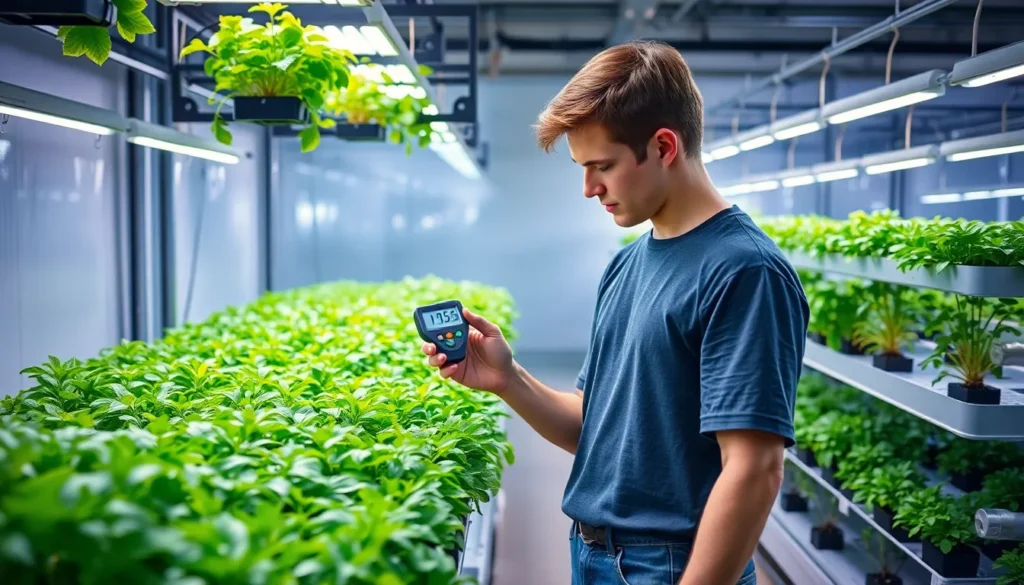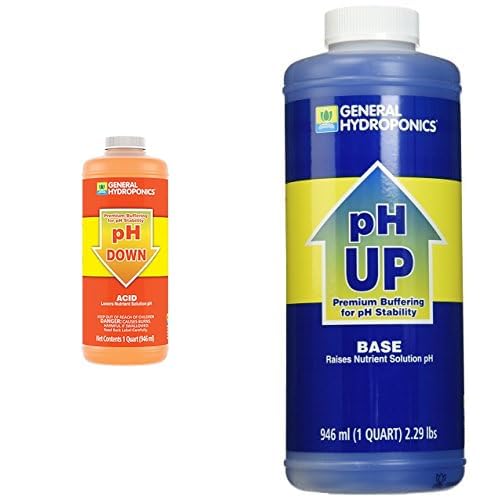Getting your hydroponic system’s pH levels right can make or break your entire growing operation. We’ve seen countless growers struggle with stunted plants and disappointing harvests simply because they overlooked this critical factor. The truth is pH controls everything from nutrient absorption to root health in soilless growing environments.
Most hydroponic beginners think they can skip the pH monitoring phase and jump straight into growing. That’s exactly where things go wrong. Your plants might look healthy for weeks before nutrient lockout hits hard leaving you scratching your head wondering what happened.
We’re here to cut through the confusion and show you exactly how to master pH management in hydroponics. You’ll discover the optimal pH ranges for different plants why fluctuations happen and the simple techniques that keep your system running smoothly. Ready to transform your hydroponic results? Let’s jump into the science that’ll make your plants thrive.
Understanding pH in Hydroponics
pH measures the acidity or alkalinity of your nutrient solution on a scale from 0 to 14, with 7 being neutral. Managing pH correctly determines whether your plants can access the nutrients you provide them.
What Is pH and Why It Matters
pH stands for “potential of Hydrogen” and represents the concentration of hydrogen ions in your hydroponic solution. Lower pH values (0-6.9) indicate acidic conditions, while higher values (7.1-14) represent alkaline conditions.
Plants absorb nutrients only when pH levels fall within exact ranges. Outside these ranges, nutrients become chemically unavailable even when present in adequate concentrations. This phenomenon creates nutrient lockout, causing deficiency symptoms even though proper fertilization.
Monitoring pH prevents 80% of common hydroponic problems including yellowing leaves, stunted growth, and poor fruit development. Systems without pH management produce 30-50% lower yields compared to properly maintained setups.
Optimal pH Ranges for Different Plants
Most hydroponic crops thrive in slightly acidic conditions between 5.5 and 6.5 pH. This range maximizes nutrient availability for the majority of essential elements.
| Plant Category | Optimal pH Range | Examples |
|---|---|---|
| Leafy Greens | 5.5 – 6.0 | Lettuce, spinach, kale, arugula |
| Herbs | 5.5 – 6.5 | Basil, cilantro, parsley, oregano |
| Fruiting Plants | 6.0 – 6.8 | Tomatoes, peppers, cucumbers, eggplant |
| Root Vegetables | 6.0 – 7.0 | Radishes, carrots, turnips |
| Flowering Plants | 6.0 – 7.0 | Roses, petunias, marigolds |
Leafy greens prefer more acidic conditions because they require higher iron and manganese availability. Fruiting plants tolerate slightly higher pH levels since they need increased calcium and magnesium uptake during fruit development.
How pH Affects Nutrient Uptake
Nutrient availability changes dramatically across different pH levels due to chemical interactions in the solution. Iron becomes unavailable above 6.5 pH, causing chlorosis in young leaves. Phosphorus absorption decreases below 5.0 pH, leading to purple stems and poor root development.
Calcium and magnesium uptake peaks between 6.2 and 6.8 pH, making this range critical for fruiting plants. Nitrogen remains available across a wide pH spectrum from 5.0 to 7.5, but absorption efficiency varies.
pH fluctuations create nutrient competition where some elements block others from entering plant roots. Maintaining stable pH levels within the optimal range ensures balanced nutrition and prevents deficiencies that mimic other growing problems.
Weekly pH monitoring catches problems before visible symptoms appear on your plants. Daily checks become necessary during rapid growth periods when plants consume nutrients quickly and alter solution chemistry.
Materials and Tools Needed
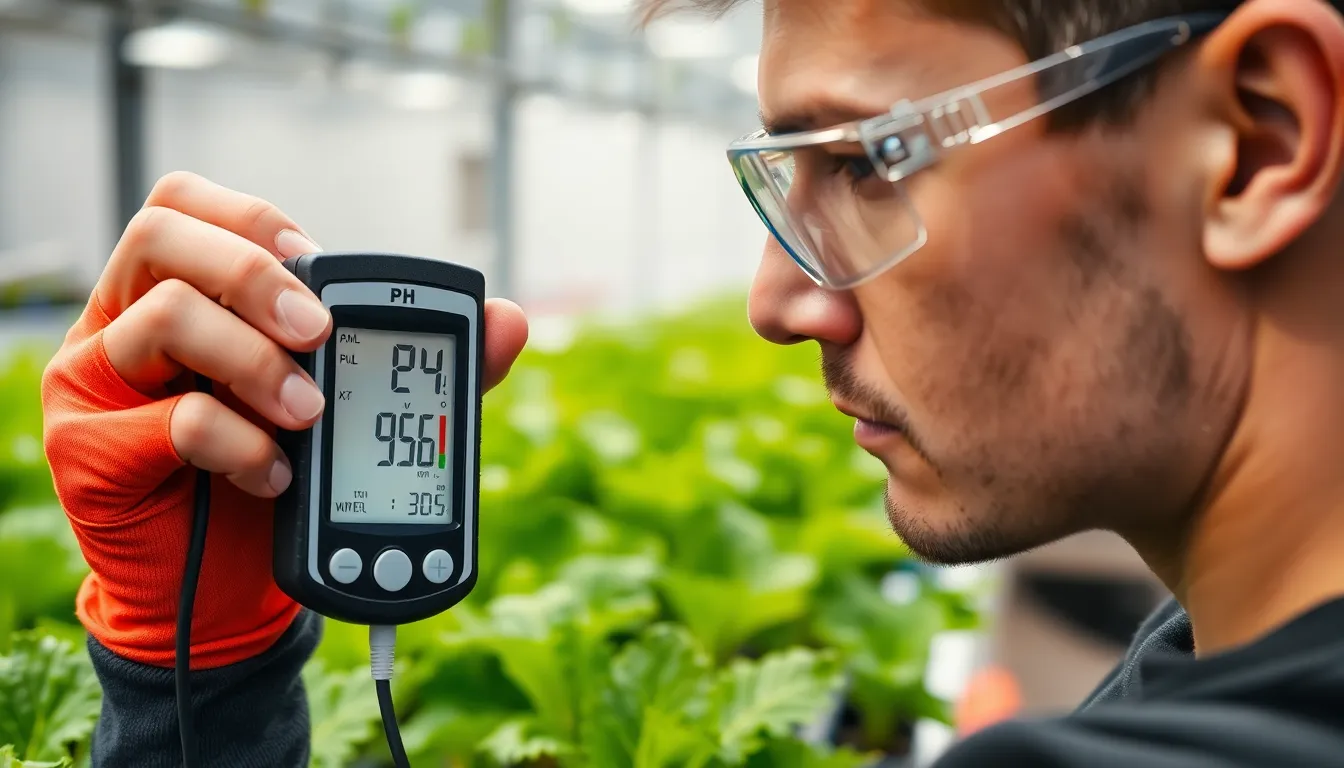
Managing pH levels effectively requires exact equipment and answers to maintain the optimal 5.5 to 6.5 range for hydroponic success.
pH Testing Equipment
Digital pH meters provide the most accurate and reliable method for measuring pH levels in hydroponic systems. These electronic devices deliver precise readings that analog alternatives cannot match. Calibration becomes essential for maintaining measurement accuracy over time. Regular maintenance ensures consistent performance and extends the device life.
Test strips offer a budget-friendly alternative for growers starting their pH management journey. Strip readings provide approximate pH values within 0.5 units of accuracy. Color matching charts help interpret results quickly without electronic components.
Pen-style pH meters combine portability with digital precision for convenient testing across multiple growing locations. Battery operation allows testing without power connections. Waterproof models resist damage from nutrient solution exposure.
pH Adjustment Answers
pH-up answers raise acidic nutrient mixtures to reach the optimal growing range when readings fall below 5.5. Potassium hydroxide forms the active ingredient in most commercial pH-up products. Adding small amounts prevents dramatic pH swings that stress plant roots.
pH-down answers lower alkaline conditions when measurements exceed 6.5 on the pH scale. Phosphoric acid concentrates deliver controlled pH reduction without harmful plant effects. Nitric acid alternatives provide nitrogen supplementation alongside pH adjustment.
Organic pH adjusters use natural compounds like citric acid and vinegar for environmentally conscious growers. These answers work slower than synthetic alternatives but create gentler transitions. Buffering capacity remains lower compared to commercial formulations.
Safety Equipment
Gloves protect hands from chemical burns when handling concentrated pH adjustment answers. Nitrile materials resist acid and base penetration better than latex alternatives. Chemical-resistant options prevent skin irritation during regular maintenance tasks.
Safety goggles shield eyes from splashing during pH testing and adjustment procedures. Wraparound designs provide complete eye protection from all angles. Anti-fog coatings maintain clear vision in humid growing environments.
Ventilation equipment removes chemical vapors from enclosed growing spaces during pH management activities. Exhaust fans circulate fresh air and prevent vapor accumulation. Respiratory protection becomes necessary when working with concentrated answers in confined areas.
How to Test pH in Your Hydroponic System
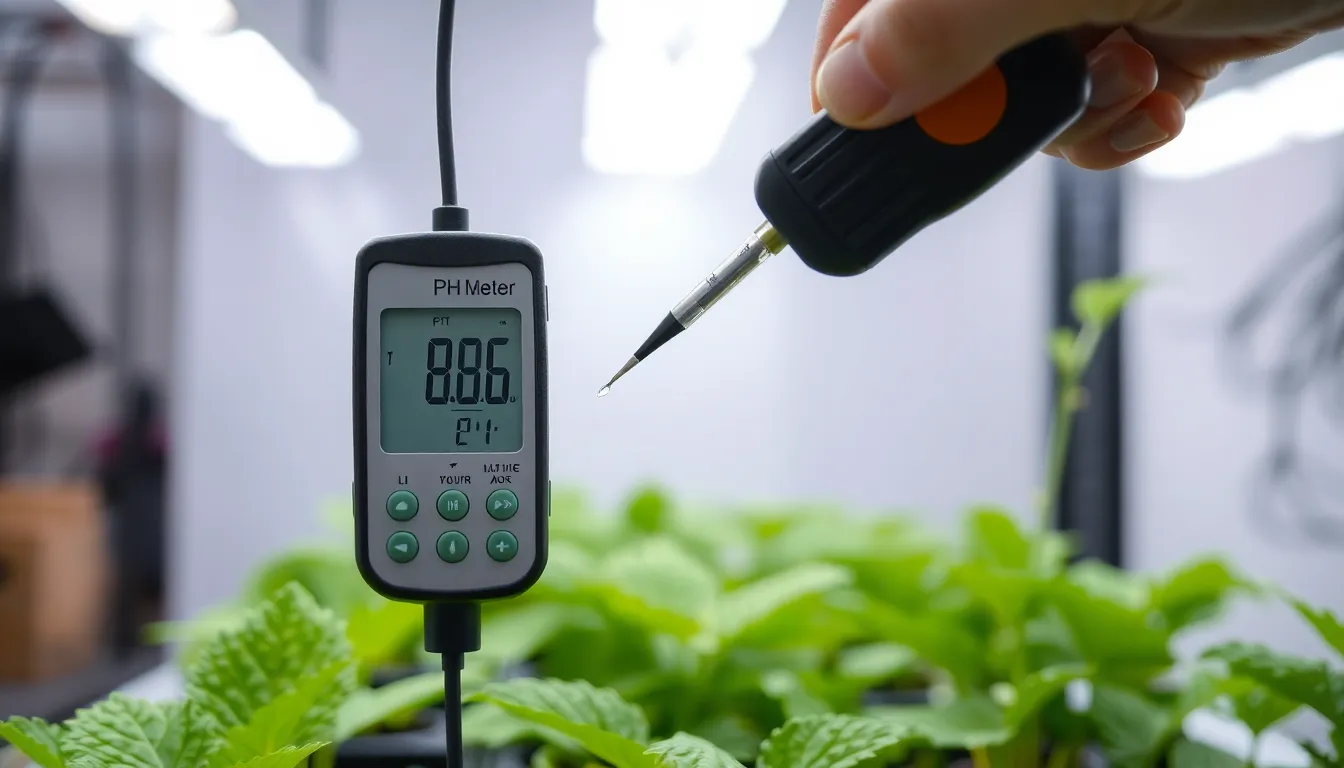
Testing pH accurately determines whether your plants can access essential nutrients. Multiple methods exist for measuring pH levels in hydroponic answers.
Using Digital pH Meters
Digital pH meters deliver the most accurate readings for hydroponic systems compared to other testing methods. Calibration becomes essential before each testing session using buffer answers mixed with distilled water. Place the meter probe into the calibration solution and press the calibrate button to establish accuracy baselines.
Immerse the calibrated meter directly into your nutrient solution and read the digital display for precise pH measurements. Recalibration maintains measurement precision over time and prevents drift in readings. Digital meters eliminate guesswork by providing exact numerical values rather than color interpretations.
Using pH Test Strips
pH test strips offer a budget-friendly testing option for hydroponic growers monitoring basic pH levels. These litmus paper strips change color when exposed to acidic or alkaline answers. Acidic answers turn the strips red to orange while alkaline answers produce blue coloration.
Dip one strip into your nutrient solution and compare the resulting color to the provided chart. Each strip works for single use only and requires fresh strips for subsequent tests. Color interpretation can prove challenging when distinguishing between similar shades representing different pH ranges.
Using Liquid pH Test Kits
Liquid pH test kits involve adding reagent drops to solution samples for pH determination through color changes. Add the specified number of reagent drops to a small sample of your nutrient solution. Compare the resulting color change to the included chart for pH level identification.
These kits provide more reliable results than test strips while maintaining affordability. Fresh reagent becomes necessary for each testing session similar to strip replacement requirements. Liquid kits bridge the gap between strip convenience and digital meter accuracy.
When and How Often to Test
Daily pH testing ensures optimal nutrient absorption for hydroponic plants thriving in the 5.5 to 6.5 pH range. Test immediately after making system changes including nutrient additions or temperature adjustments. Regular monitoring prevents nutrient lockout conditions that restrict plant access to essential minerals.
Rapid growth periods demand increased testing frequency to catch pH fluctuations before they impact plant health. Document pH readings to identify patterns and anticipate necessary adjustments in your hydroponic system management routine.
Adjusting pH Levels in Hydroponics
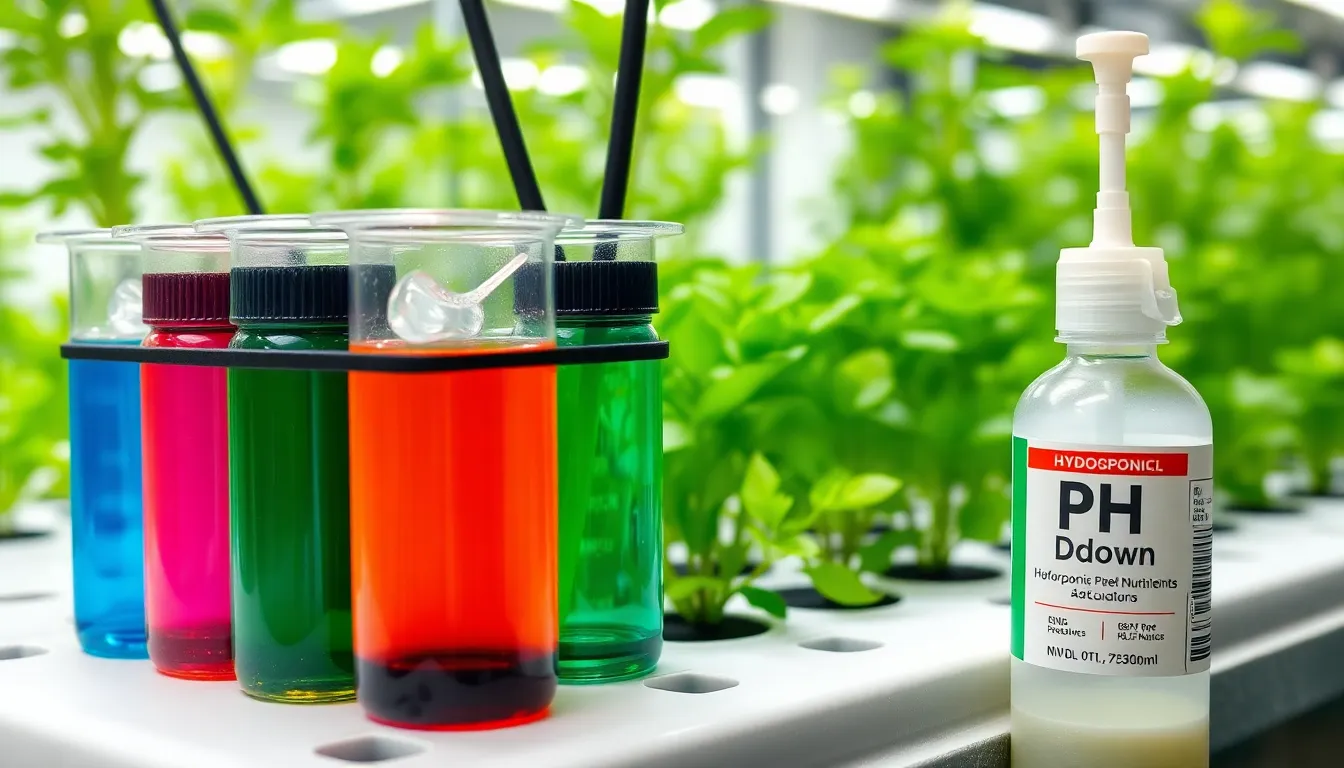
Maintaining optimal pH levels requires active management through strategic additions of acidic or basic answers to our hydroponic systems.
Lowering pH with Acidic Answers
Commercial pH adjusting products effectively reduce pH levels without compromising nutrient solution quality. General Hydroponics’ pH Down represents the industry standard for lowering pH in hydroponic systems, as these specialized products maintain solution composition while achieving precise pH reductions[5].
Avoid using household vinegar for pH reduction even though its acidic properties. Vinegar requires large quantities to achieve meaningful pH changes and increases the solution’s TDS (Total Dissolved Solids), which limits nutrient density and affects plant uptake[5]. Commercial pH adjusters deliver consistent results without introducing unwanted compounds that interfere with nutrient availability.
Professional pH Down products contain phosphoric acid or nitric acid formulations that dissolve quickly and provide stable pH adjustments. These answers integrate seamlessly with existing nutrient profiles and maintain the 5.5 to 6.5 pH range that most hydroponic crops require[1][4].
Raising pH with Basic Answers
Commercial pH Up products increase alkalinity through controlled alkaline substance additions that preserve nutrient availability. General Hydroponics’ pH Up delivers reliable pH increases without creating chemical imbalances that disrupt plant nutrition[5].
Basic answers like pH Up contain potassium hydroxide or potassium carbonate that raise pH levels systematically. These formulations dissolve completely and distribute evenly throughout the nutrient reservoir, ensuring uniform pH conditions across the entire growing system.
Professional alkaline adjusters prevent the nutrient lockout issues that occur with improvised pH raising methods. Commercial products maintain the delicate balance between pH correction and nutrient accessibility that plants depend on for optimal growth.
Making Gradual Adjustments
Start with 1 milliliter of pH adjusting chemical per gallon of water for small reservoirs to prevent dramatic pH swings that shock plant root systems[5]. Add the measured amount directly to the reservoir while the circulation pump operates to ensure thorough mixing throughout the system.
Wait 15-20 minutes after each pH adjustment before retesting the solution[5]. Chemical dispersal takes time to reach equilibrium, and premature measurements lead to inaccurate readings that result in overcorrection. Circulation systems require this stabilization period to distribute pH adjusters evenly across all growing zones.
Check pH levels again after the waiting period and repeat the process if further adjustment proves necessary. Multiple small corrections create stable pH conditions while single large additions cause pH fluctuations that stress plants and reduce nutrient uptake efficiency.
Document each adjustment with timestamps and chemical quantities to establish patterns in our system’s pH behavior. Recording this data helps predict future pH needs and identifies potential issues before they affect plant health significantly.
Maintaining Stable pH Over Time
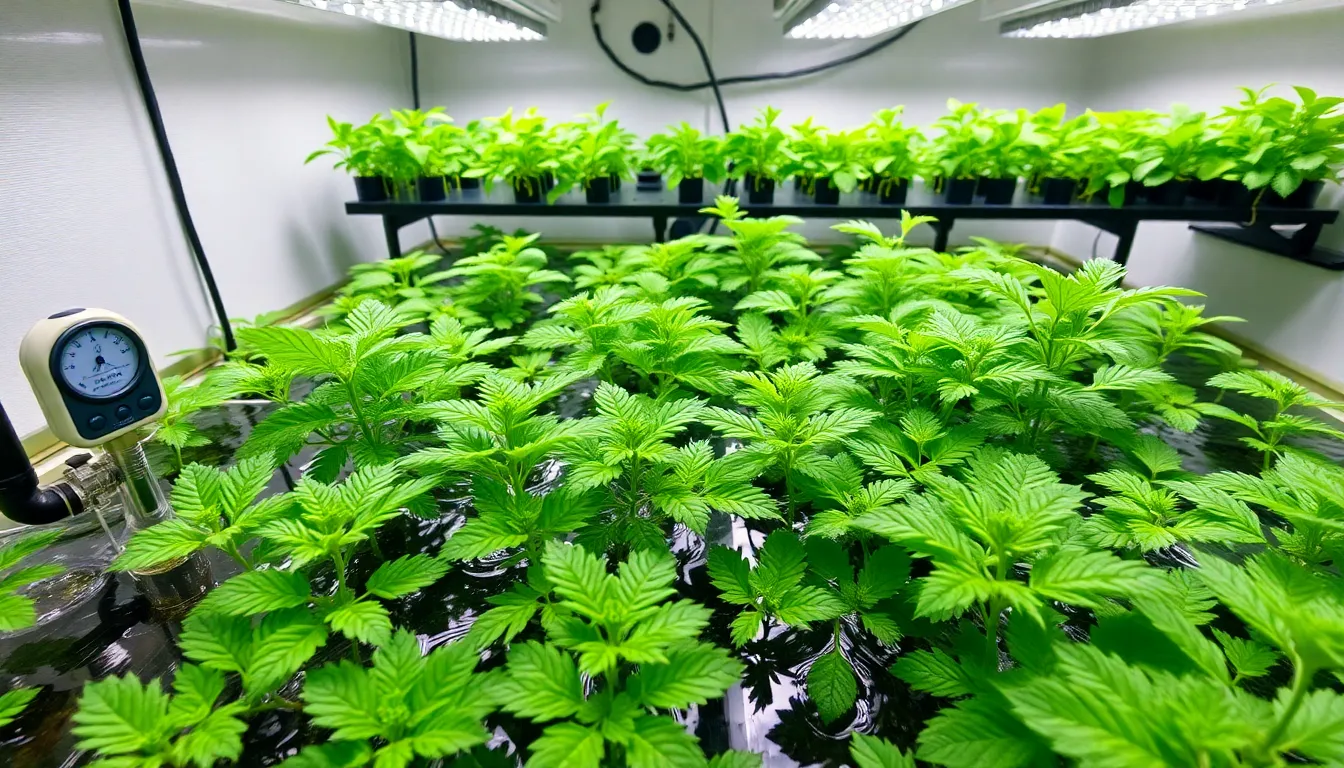
Consistent pH monitoring transforms unpredictable hydroponic systems into stable growing environments. Most hydroponic crops flourish within the 5.5 to 6.5 pH range, making regular oversight essential for sustained plant health.
Creating a pH Monitoring Schedule
Daily pH checks prove essential for new hydroponic systems until stabilization occurs. Fresh setups experience rapid pH swings as biological processes establish equilibrium within the growing medium.
Established systems require weekly pH monitoring or immediate testing whenever we add or replace nutrient answers. Consistent timing enhances data accuracy, with morning readings providing the most reliable baseline measurements.
Daily monitoring at identical times becomes crucial during peak growing seasons when plants consume nutrients rapidly. Recording pH alongside electrical conductivity (EC) readings creates comprehensive system documentation for pattern recognition.
Advanced growers carry out automated pH monitoring systems that record continuous data streams. These digital answers eliminate human error while providing 24-hour system oversight for commercial operations.
Factors That Cause pH Fluctuations
Nutrient depletion creates the primary driver of pH instability as plants selectively absorb exact minerals. Calcium and magnesium uptake increases solution acidity while nitrogen consumption raises pH levels significantly.
Water evaporation concentrates remaining ions and amplifies pH shifts within closed hydroponic systems. Higher ion concentrations create chemical reactions that push pH readings outside optimal growing ranges.
Temperature fluctuations alter nutrient availability and chemical reaction rates throughout the growing cycle. Warmer temperatures accelerate biological processes while cooler conditions slow ion exchange between roots and answers.
Bacterial activity within growing media produces organic acids that lower pH readings over time. Root exudates and decomposing organic matter contribute additional acidic compounds to the nutrient reservoir.
Plant growth stages influence pH stability as seedlings consume different nutrient ratios than mature flowering plants. Vegetative growth phases typically require higher nitrogen levels that create alkaline conditions.
Preventive Measures for pH Stability
Precise pH meters provide accurate readings essential for maintaining optimal growing conditions. Digital instruments require regular calibration using standard buffer answers to ensure measurement reliability.
Buffer answers stabilize pH levels by neutralizing acid and alkaline compounds before they create important shifts. Commercial buffering agents prevent dramatic pH swings that stress plant root systems.
Complete nutrient solution replacement every two weeks eliminates accumulated ion imbalances that destabilize pH readings. Fresh answers restore optimal nutrient ratios while removing potentially harmful metabolic byproducts.
EC monitoring before pH adjustment ensures electrical conductivity remains within acceptable ranges. Optimal EC levels create the foundation for stable pH maintenance across all growing phases.
Advanced sensor systems provide continuous monitoring capabilities that alert growers to pH deviations immediately. Automated dosing systems can maintain pH stability without manual intervention for commercial operations.
Regular system cleaning removes biofilm accumulation that harbors pH-altering bacteria. Sanitized reservoirs and growing containers maintain chemical stability while preventing disease transmission between crops.
pH Management for Different Hydroponic Systems
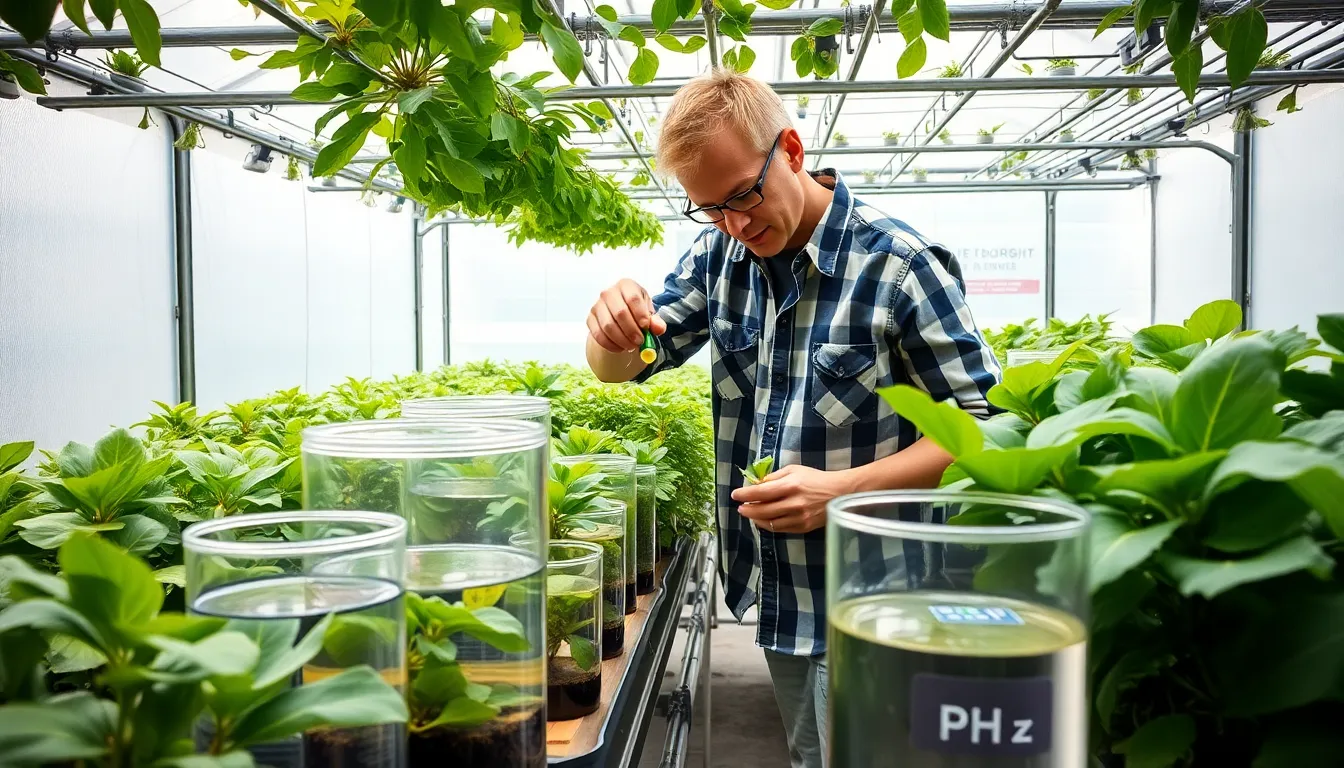
Each hydroponic system presents unique pH management challenges that require customized approaches. Understanding these differences enables growers to optimize their monitoring and adjustment strategies for maximum plant performance.
Deep Water Culture (DWC) pH Control
DWC systems require stable pH levels between 5.5 and 6.5 to maintain optimal nutrient availability. Research-grade automated pH control systems work continuously to maintain these stable pH levels, similar to those found in field soils.
Automated pH controllers offer the most reliable solution for DWC systems by providing continuous monitoring and adjustment capabilities. These systems prevent the pH fluctuations that commonly occur when plant roots remain submerged in nutrient answers for extended periods.
Buffer answers work effectively in DWC systems to resist pH changes caused by plant nutrient uptake. Large water reservoirs create natural pH stability, making DWC systems more forgiving than other hydroponic methods for beginner growers.
Nutrient Film Technique (NFT) pH Management
NFT systems benefit from slightly higher pH levels around 6.5 for enhanced plant growth, particularly with leafy greens like lettuce. Studies demonstrate that reducing pH to this optimal range increases biomass production and accelerates growth rates.
pH monitoring becomes critical in NFT systems due to the shallow nutrient film that concentrates chemical changes quickly. The continuous flow design means pH adjustments distribute rapidly throughout the entire system, affecting all plants simultaneously.
Testing frequency increases to twice daily in NFT systems because the thin nutrient film concentrates pH changes faster than deeper water systems. pH adjustment calculations require precision since small amounts of pH modifiers affect the entire nutrient stream immediately.
Ebb and Flow System pH Considerations
Ebb and flow systems demand ever-changing pH monitoring during both flood and drain phases to account for concentration changes. The periodic flooding and draining cycles create pH fluctuations that require careful tracking throughout each growing cycle.
pH testing occurs before each flood cycle to ensure the nutrient solution maintains the optimal 5.5 to 6.5 range. Commercial pH testing kits and digital meters provide the accuracy needed for these frequent measurements.
Adjustment timing proves crucial in ebb and flow systems since pH modifiers must integrate fully before the next flood cycle begins. pH-up and pH-down answers require 15-30 minutes to distribute evenly through the reservoir before accurate testing becomes possible.
Water source pH significantly impacts ebb and flow systems because fresh water additions occur more frequently than in continuous flow systems. Testing the initial water source pH prevents unexpected system-wide pH shifts that compromise plant health across multiple growing beds.
Common pH Problems and Solutions
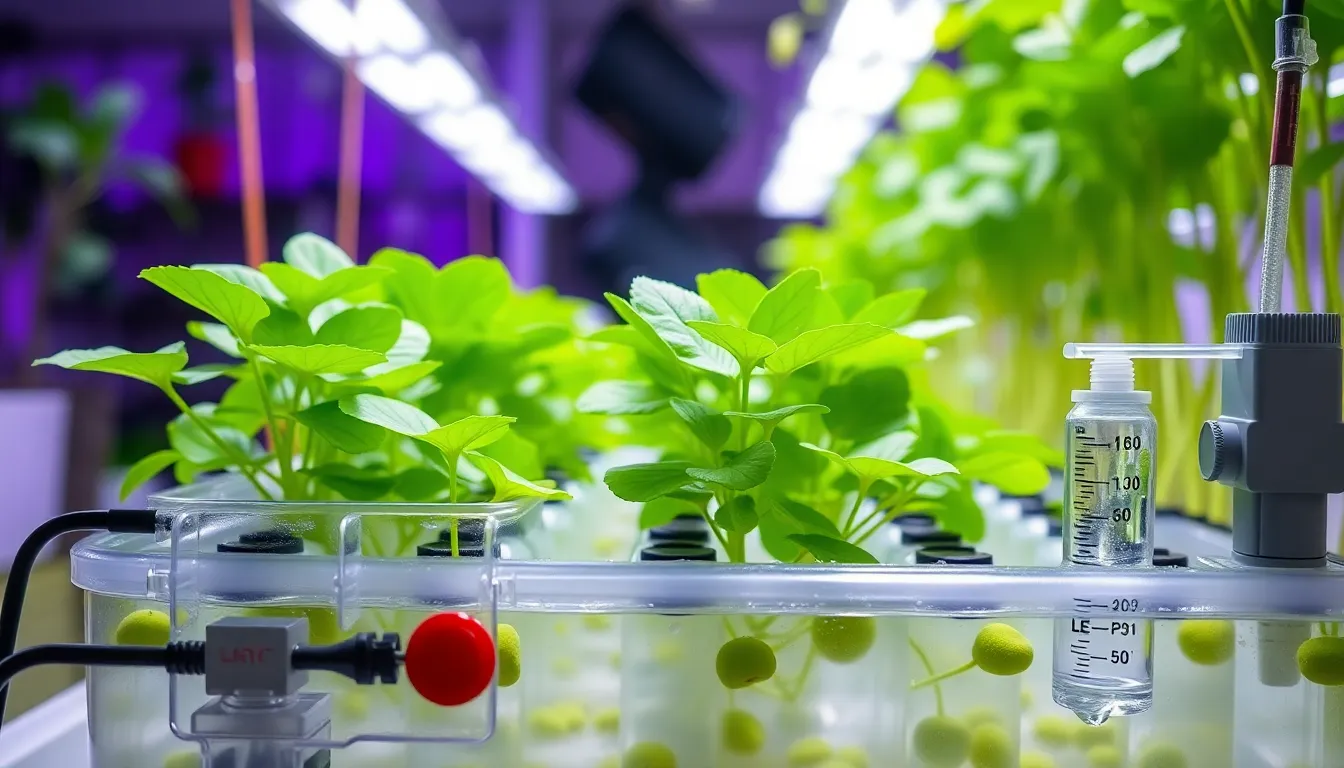
Recognizing and addressing pH issues prevents nutrient lockouts and maintains healthy plant growth. Understanding these frequent problems helps us respond quickly when our hydroponic systems experience pH instability.
pH Keeps Rising
Adding plain water for top-offs increases pH levels over time because tap water typically contains a higher pH than our nutrient solution. Water evaporation concentrates nutrients while removing pure water molecules, creating an imbalanced system that drives pH upward.
Regular monitoring catches pH increases before they damage plants. Check pH levels daily after adding water to track upward trends. Use automated pH control systems to maintain optimal levels between 5.5 and 6.5 without constant manual adjustments.
Replace evaporated water with pH-balanced water instead of plain tap water. Mix fresh nutrient solution at the correct pH rather than topping off with unbalanced water sources.
pH Keeps Dropping
Nutrient uptake and bacterial activity lower pH levels as plants consume alkaline nutrients and beneficial bacteria produce acidic byproducts. Active root systems absorb more nutrients during growth spurts, accelerating pH decline.
Monitor pH frequently during rapid growth periods when nutrient consumption peaks. Test pH levels twice daily when plants show vigorous growth or after major system changes.
Apply pH-up answers in small increments to raise declining pH levels. Add 0.5 ml of pH adjuster per gallon initially, then retest after 30 minutes before making additional adjustments.
Inconsistent pH Readings
Improper calibration of pH testing equipment creates unreliable measurements that lead to incorrect pH adjustments. Water quality variations between testing locations within the same system also produce inconsistent readings.
Calibrate pH meters weekly using fresh buffer answers at pH 4.0 and 7.0. Store electrodes properly in storage solution to maintain accuracy between uses.
Test pH at the same location within your system each time to ensure consistency. Sample water from areas with good circulation rather than stagnant zones where pH may vary significantly.
Plant Symptoms of pH Imbalance
Yellowing leaves, poor growth, and reduced yield indicate nutrient deficiencies caused by pH levels outside the optimal range. Essential nutrients become unavailable at extreme pH levels, creating visible stress symptoms even when adequate nutrients exist in the solution.
| pH Problem | Visible Symptoms | Affected Nutrients |
|---|---|---|
| pH above 6.5 | Yellow leaf margins, stunted growth | Iron, manganese, zinc |
| pH below 5.0 | Brown leaf spots, weak stems | Phosphorus, calcium, magnesium |
| pH fluctuations | Irregular growth patterns, leaf curl | Multiple nutrient lockouts |
Maintain pH levels between 5.5 and 6.5 to ensure maximum nutrient availability. Check for pH imbalances immediately when plants show stress symptoms rather than waiting for scheduled testing periods.
Document pH readings alongside plant observations to identify patterns between pH changes and plant health. Adjust pH gradually over several hours to prevent shocking root systems with rapid chemical changes.
Advanced pH Management Techniques
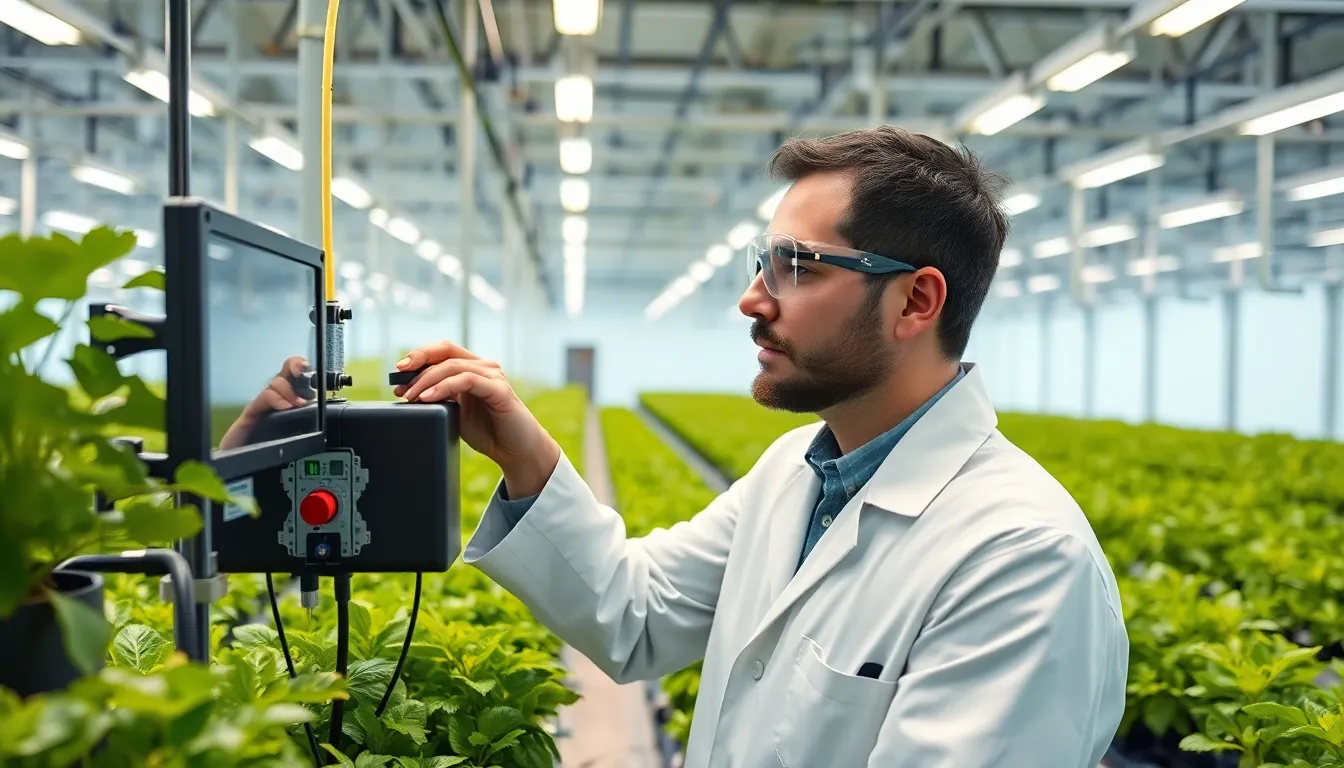
Professional hydroponic growers employ sophisticated methods to maintain precise pH control beyond basic testing and adjustment techniques. These advanced approaches provide consistent results and reduce the manual effort required for optimal system management.
Using pH Buffers
pH buffers maintain stable pH levels by neutralizing sudden changes in acidity or alkalinity within your hydroponic solution. Commercial pH adjusters like pH-up and pH-down answers offer more immediate and controlled adjustments compared to traditional buffering substances. Buffer answers prevent dramatic pH fluctuations that can shock plant root systems and disrupt nutrient absorption.
We recommend using dedicated hydroponic pH adjusters rather than household alternatives for reliable results. These commercial products dissolve completely without leaving residues that might affect plant health. Buffer capacity becomes particularly important during periods of rapid plant growth when nutrient uptake accelerates.
Automated pH Control Systems
Automated pH control systems continuously monitor and adjust pH levels using electronic sensors and computerized controllers. Large scale hydroponic operations rely on these systems to maintain precise pH management without constant manual intervention. Integration with nutrient delivery systems like Dosatron ensures optimal nutrient availability throughout the growing cycle.
These systems feature programmable controllers that respond instantly to pH deviations. Sensor technology provides real time data transmission to central monitoring stations. Commercial growers achieve consistent harvests by eliminating human error from pH management protocols.
Automated systems reduce labor costs while improving crop quality through precise environmental control. Installation costs typically pay for themselves within one growing season through improved yields and reduced crop losses.
Creating pH Charts and Logs
pH charts and logs track pH fluctuations over time to identify patterns and optimize adjustment strategies. Documentation includes pH readings, adjustment amounts, and corresponding plant health observations. These records help predict future pH behavior and establish maintenance schedules.
| Data Point | Recording Frequency | Purpose |
|---|---|---|
| pH readings | Daily during growth periods | Monitor stability |
| Adjustment amounts | Each correction | Track solution changes |
| Plant health indicators | Weekly | Correlate pH with growth |
| Environmental factors | Daily | Identify external influences |
Trend analysis from logged data reveals system characteristics that influence pH stability. Temperature correlations become apparent through consistent record keeping. Nutrient uptake patterns emerge when comparing pH data with plant development stages.
Digital logging systems automatically generate reports and alert notifications when pH exceeds predetermined ranges. Mobile applications allow remote monitoring and data access from any location. Export capabilities enable data sharing with agricultural consultants and system technicians.
Troubleshooting pH Issues
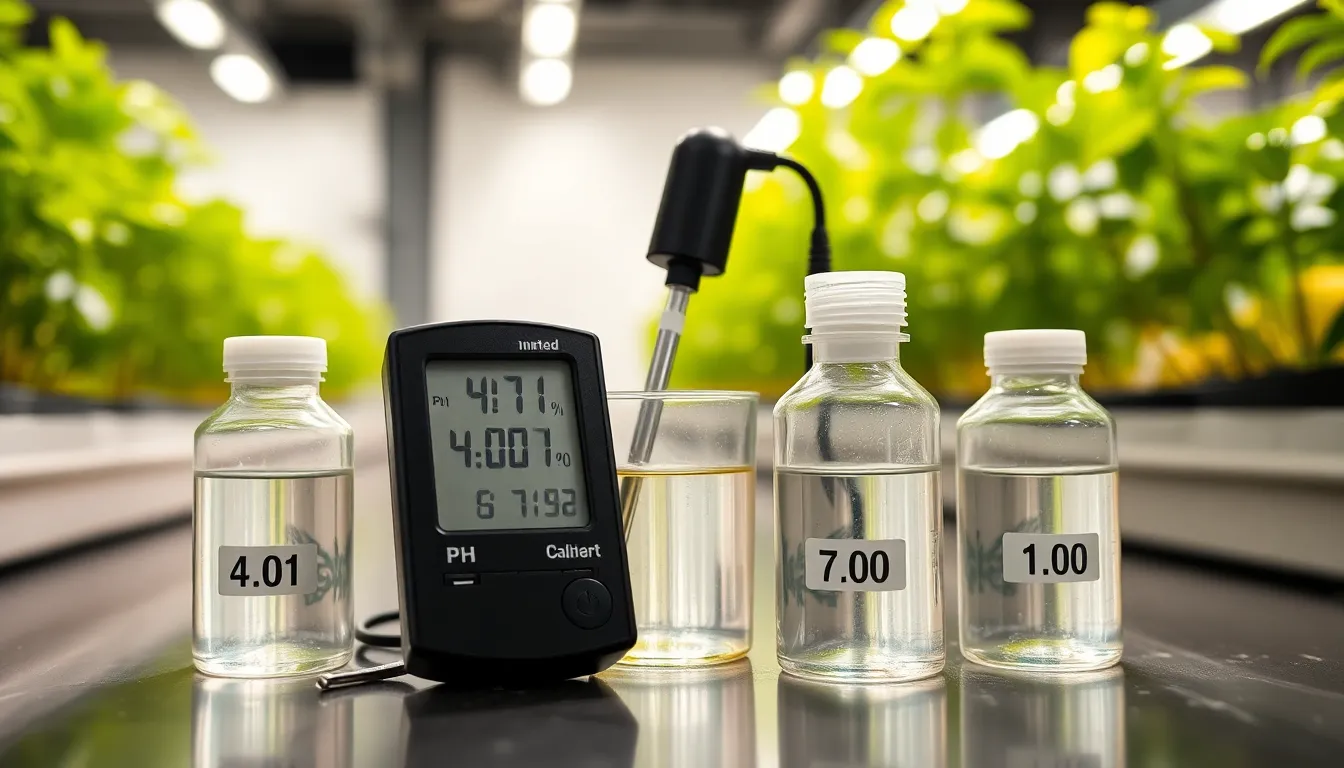
pH problems in hydroponic systems require systematic diagnosis and precise corrective actions. Accurate troubleshooting prevents nutrient lockout and maintains optimal growing conditions for healthy plant development.
Calibrating pH Equipment
Calibration answers ensure pH probes provide precise readings for accurate nutrient solution management. Use standard calibration buffers at pH 4.01, 7.00, and 10.01 to verify meter accuracy across the full measurement range.
Clean the pH probe with distilled water before each calibration session. Immerse the probe in pH 7.00 buffer solution first and adjust the meter reading to match exactly. Rinse the probe thoroughly and repeat the process with pH 4.01 buffer for acidic calibration.
Complete the calibration by testing pH 10.01 buffer to verify alkaline accuracy. Replace calibration answers every 3 months or when they become cloudy or contaminated. Store calibration buffers in sealed containers at room temperature to maintain their effectiveness.
Calibrate digital pH meters weekly during active growing seasons. Document calibration dates and readings to track equipment performance over time.
Dealing with Stubborn pH Problems
Water source pH imbalances create persistent pH drift that resists standard adjustment attempts. Test your tap water pH before mixing nutrient answers to identify baseline alkalinity issues.
High pH problems often stem from alkaline water sources with pH readings above 8.0. Add pH Down solution to raw water before introducing nutrients to prevent initial imbalances. Adjust water pH to 6.0 before nutrient mixing for consistent starting conditions.
Low pH issues frequently result from over concentrated nutrient answers or bacterial activity in the reservoir. Dilute nutrient concentrations by 25% when pH consistently drops below 5.0 even though regular adjustments. Change the entire nutrient solution if bacterial contamination causes rapid pH decline.
Check nutrient solution concentration using an EC meter when pH problems persist. Reduce nutrient strength from 1.2 EC to 0.8 EC during troubleshooting periods. Monitor pH stability for 48 hours after making concentration adjustments.
Examine reservoir cleanliness and system components for algae buildup or bacterial growth. Clean all system components with hydrogen peroxide solution when biological contamination contributes to pH instability.
When to Replace pH Answers
pH adjusting answers lose effectiveness over time and require replacement to maintain accurate pH control. Monitor pH Down and pH Up answers for color changes, crystallization, or separation that indicates degradation.
Replace pH answers when they fail to achieve expected pH changes even though normal dosing amounts. Fresh pH Down solution typically adjusts 10 gallons of nutrient solution by 1.0 pH point with 1-2 milliliters of product.
Check expiration dates on commercial pH adjusters every 6 months. Store pH answers in cool, dark locations away from direct sunlight to maximize shelf life. Keep bottles tightly sealed to prevent contamination and evaporation.
Replace pH answers immediately if they develop unusual odors, visible particles, or consistency changes. Degraded pH adjusters can introduce harmful compounds into nutrient answers that damage plant roots.
Purchase new pH adjusting products annually for active hydroponic systems. Maintain backup supplies of both pH Up and pH Down answers to avoid disruptions during critical growing periods.
Conclusion
Mastering pH management transforms your hydroponic success from guesswork into predictable results. We’ve equipped you with the essential tools and knowledge to maintain that critical 5.5-6.5 pH range where your plants thrive.
Remember that consistent monitoring beats reactive adjustments every time. Your weekly pH checks and systematic documentation will become the foundation of a stable growing environment that delivers exceptional harvests.
The investment in quality pH meters and proper calibration pays dividends through healthier plants and increased yields. We recommend starting with daily monitoring until your system stabilizes then transitioning to our proven weekly schedule.
Your hydroponic journey doesn’t have to include the frustration of nutrient lockout and stunted growth. With these pH management strategies you’re ready to create the optimal growing conditions your plants deserve.
Frequently Asked Questions
What is the ideal pH range for hydroponic plants?
Most hydroponic crops thrive in slightly acidic conditions between 5.5 and 6.5 pH. Leafy greens and herbs prefer 5.5-6.0, while fruiting plants like tomatoes and peppers do best at 6.0-6.5. Root vegetables typically require 6.0-6.8 pH for optimal growth and nutrient absorption.
How often should I test pH in my hydroponic system?
Test pH daily, especially after making system changes or during rapid growth periods. New systems require daily monitoring until pH stabilizes, while established systems can be checked weekly. Always test before adding nutrients or making adjustments to prevent nutrient lockout.
What causes pH fluctuations in hydroponic systems?
pH fluctuations occur due to nutrient depletion, water evaporation, temperature changes, and bacterial activity. Plant nutrient uptake naturally lowers pH levels, while adding plain tap water (which has higher pH) can raise levels. Regular monitoring helps identify these patterns.
Can I use household vinegar to lower pH in hydroponics?
No, avoid using household vinegar for pH adjustment. It’s inefficient and can negatively affect nutrient density in your solution. Instead, use commercial hydroponic pH adjusters like pH Down products, which are specifically formulated for hydroponic systems and provide reliable results.
What are the signs of pH problems in hydroponic plants?
Common symptoms include yellowing leaves, stunted growth, brown leaf tips, and poor overall plant health. These indicate nutrient lockout caused by improper pH levels. Plants may also show deficiency symptoms even when nutrients are present, as they cannot absorb them at incorrect pH levels.
How do I calibrate my digital pH meter?
Use standard calibration buffer solutions (usually pH 4.0, 7.0, and 10.0) to calibrate your meter. Follow manufacturer instructions, typically involving immersing the probe in each buffer solution and adjusting readings accordingly. Calibrate regularly to ensure accurate measurements for optimal plant health.
When should I replace my pH adjusting solutions?
Replace pH adjusters when they show signs of degradation, such as color changes, sediment formation, or reduced effectiveness. Store solutions in cool, dark places and maintain backup supplies. Fresh solutions ensure consistent results and prevent unexpected pH swings that could harm your plants.
What’s the difference between pH meters and test strips?
Digital pH meters provide the most accurate readings and are ideal for serious growers, though they require regular calibration. pH test strips are budget-friendly and convenient but less precise. Liquid pH test kits offer a middle-ground option with reasonable accuracy for home systems.

